Abstract
Megraw, Robert E. (Iowa State University, Ames), and Russell J. Beers. Glyoxylate metabolism in growth and sporulation of Bacillus cereus. J. Bacteriol. 87:1087–1093. 1964.—Isocitrate lyase and malate synthetase were found in cell-free extracts of Bacillus cereus T. The patterns of synthesis of enzymes of the glyoxylic acid cycle were dependent upon the medium in which the organism was grown. Cells grown in acetate or in an acetate precursor, such as glucose, produced enzymes of the glyoxylic acid cycle in greatly diminished quantities, as compared with cells grown in media containing glutamate or yeast extract as principal carbon sources. Glutamate-grown cells had high isocitrate lyase activity but very low malate synthetase activity. Glyoxylate produced in this situation is metabolized by alternate pathways: conversion to tartronic semialdehyde and the latter to glyceric acid, thus providing evidence for a glycerate pathway; and reduction to glycolate (the reverse of this reaction was present at a low rate). Enzymatic activity of the glyoxylic acid cycle declines at the point where sporogenesis begins, indicating a metabolic shift for the synthesis of spore material.
Full text
PDF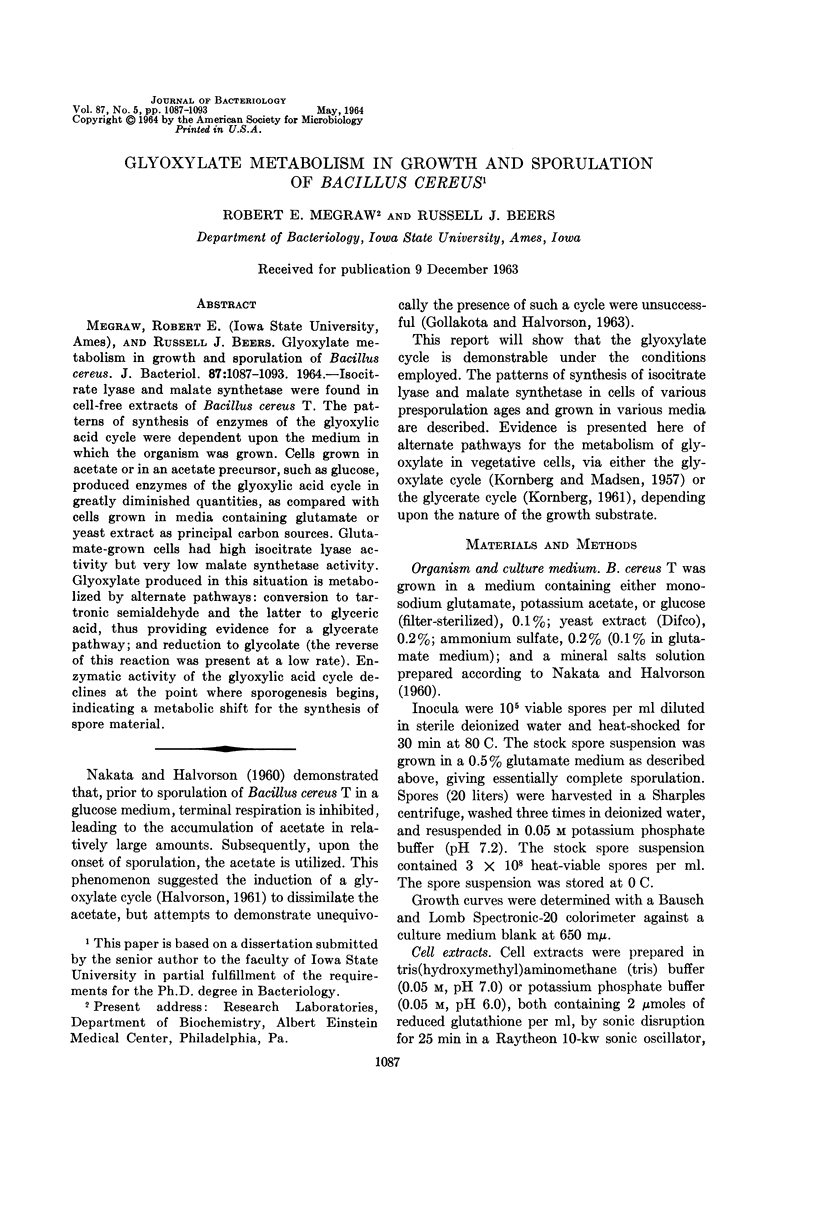
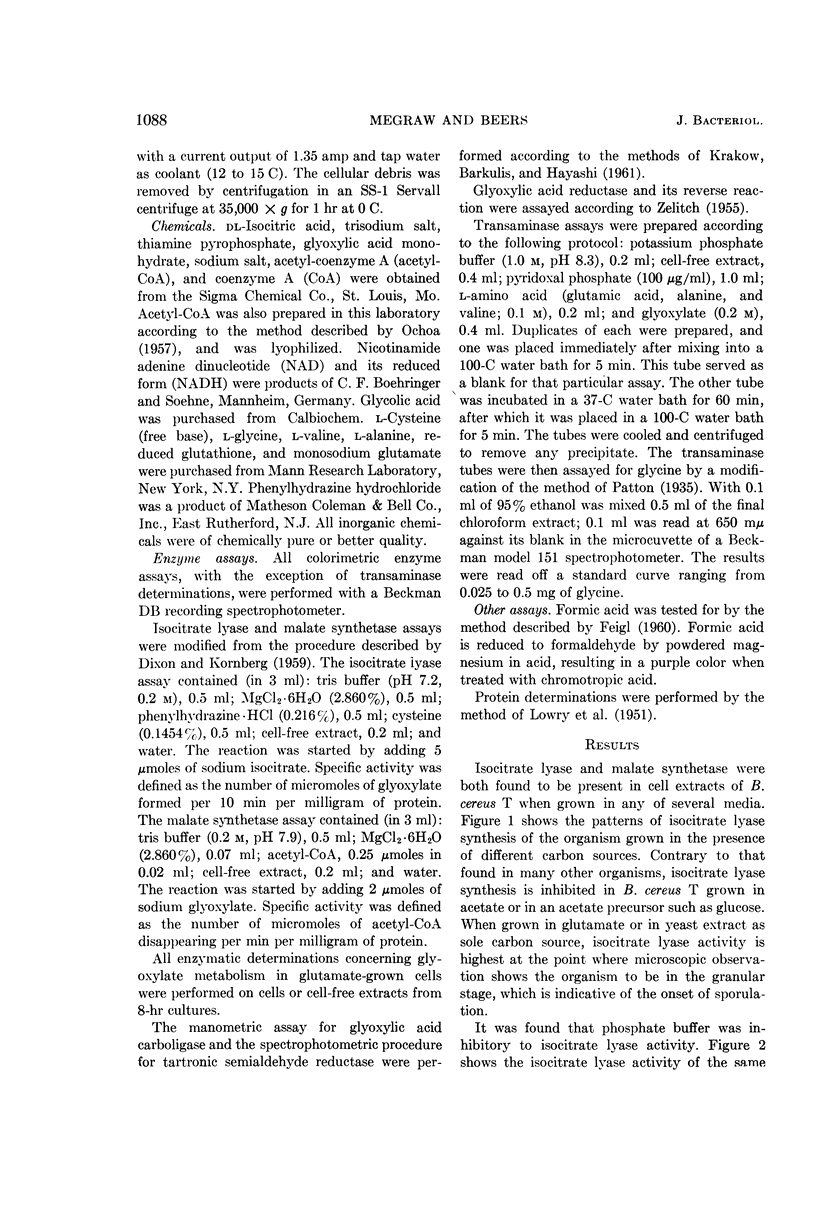


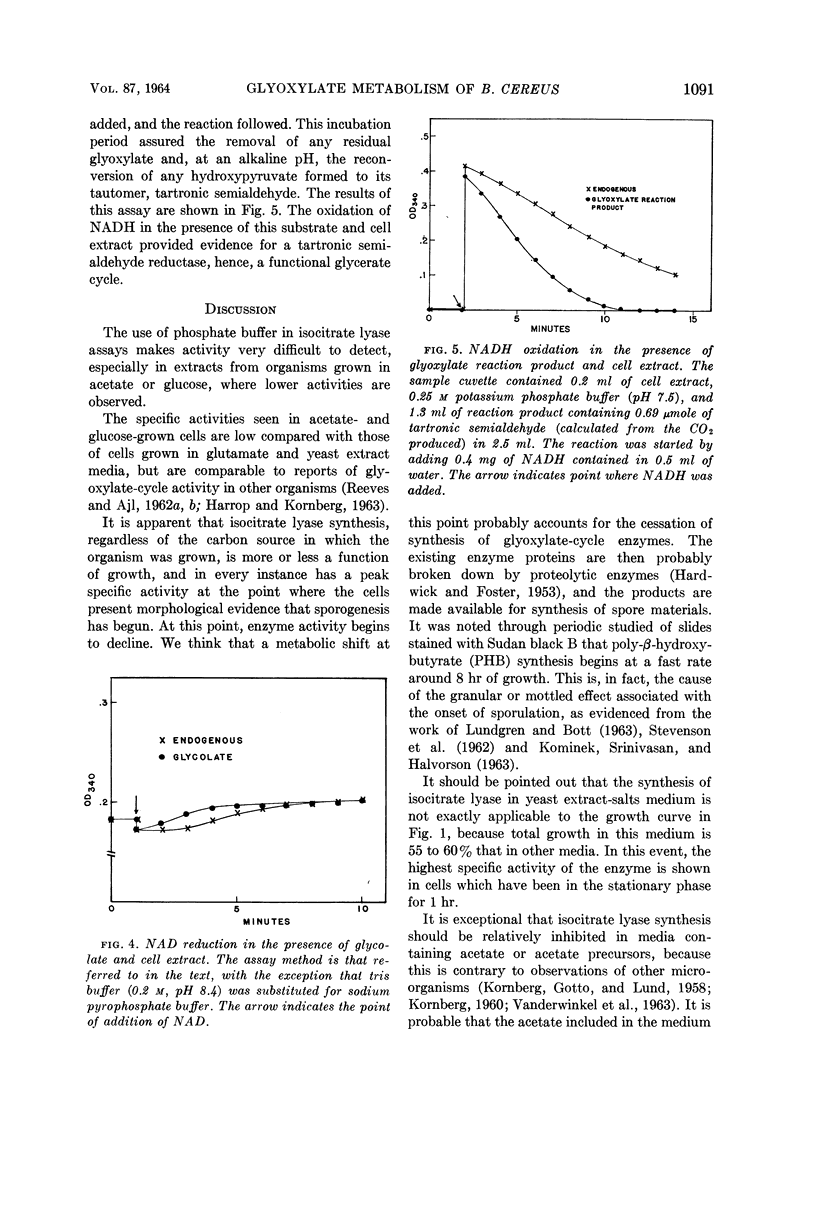
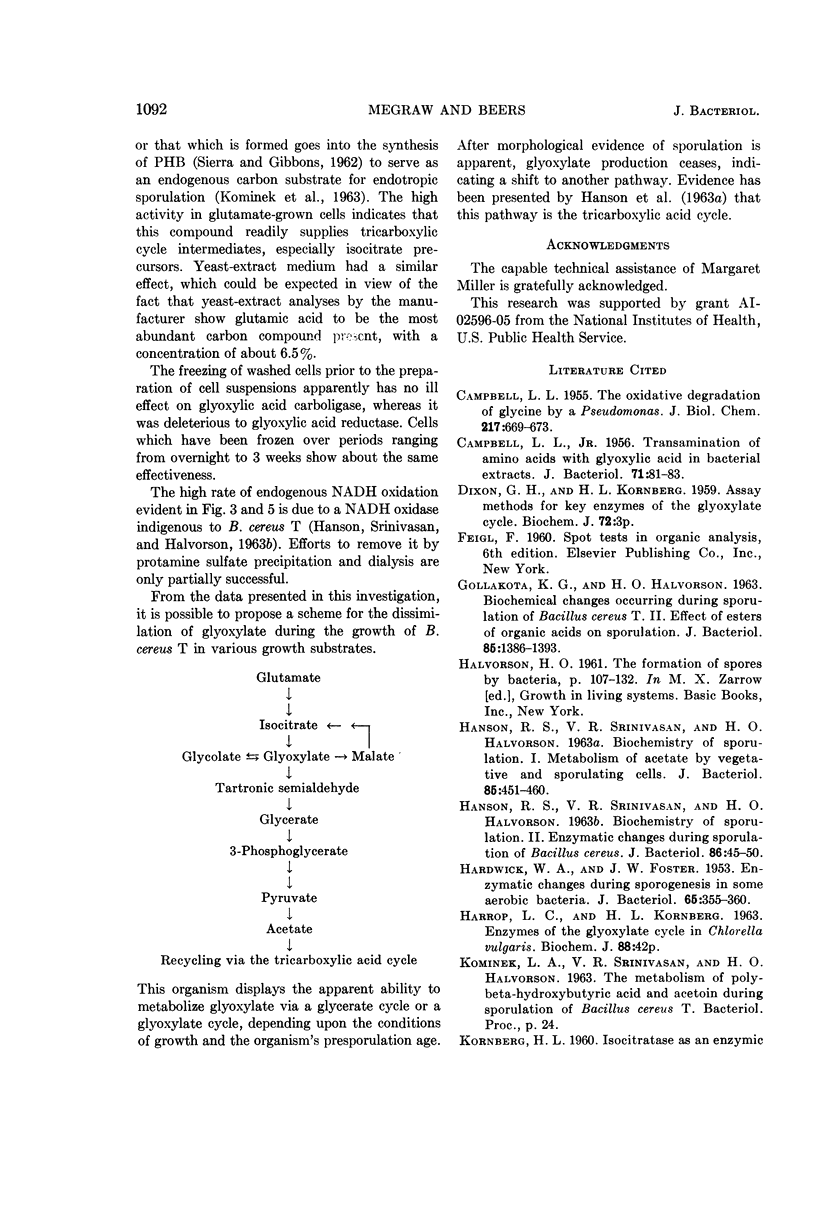
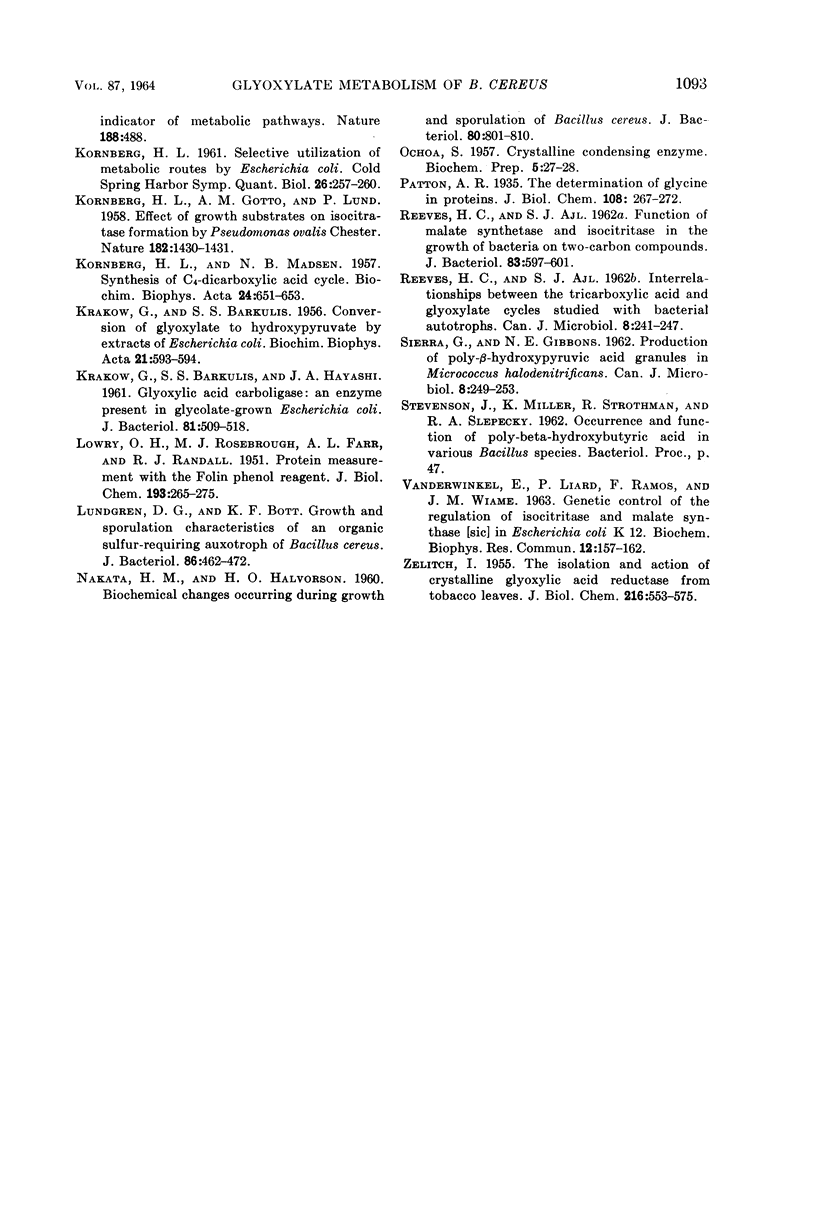
Selected References
These references are in PubMed. This may not be the complete list of references from this article.
- BARKULIS S. S., KRAKOW G. Conversion of glyoxylate to hydroxypyruvate by extracts of Escherichia coli. Biochim Biophys Acta. 1956 Sep;21(3):593–594. doi: 10.1016/0006-3002(56)90208-6. [DOI] [PubMed] [Google Scholar]
- CAMPBELL L. L., Jr The oxidative degradation of glycine by a Pseudomonas. J Biol Chem. 1955 Dec;217(2):669–673. [PubMed] [Google Scholar]
- CAMPBELL L. L., Jr Transamination of amino acids with glyoxylic acid in bacterial extracts. J Bacteriol. 1956 Jan;71(1):81–83. doi: 10.1128/jb.71.1.81-83.1956. [DOI] [PMC free article] [PubMed] [Google Scholar]
- GOLLAKOTA K. G., HALVORSON H. O. BIOCHEMICAL CHANGES OCCURRING DURING SPORULATION OF BACILLUS CEREUS T. II. EFFECT OF ESTERS OF ORGANIC ACIDS ON SPORULATION. J Bacteriol. 1963 Jun;85:1386–1393. doi: 10.1128/jb.85.6.1386-1393.1963. [DOI] [PMC free article] [PubMed] [Google Scholar]
- HANSON R. S., SRINIVASAN V. R., HALVORSON H. O. BIOCHEMISTRY OF SPORULATION. II. ENZYMATIC CHANGES DURING SPORULATION OF BACILLUS CEREUS. J Bacteriol. 1963 Jul;86:45–50. doi: 10.1128/jb.86.1.45-50.1963. [DOI] [PMC free article] [PubMed] [Google Scholar]
- HANSON R. S., SRINIVASAN V. R., HALVORSON H. O. Biochemistry of sporulation. I. Metabolism of acetate by vegetative and sporulating cells. J Bacteriol. 1963 Feb;85:451–460. doi: 10.1128/jb.85.2.451-460.1963. [DOI] [PMC free article] [PubMed] [Google Scholar]
- HARDWICK W. A., FOSTER J. W. Enzymatic changes during sporogenesis in some aerobic bacteria. J Bacteriol. 1953 Apr;65(4):355–360. doi: 10.1128/jb.65.4.355-360.1953. [DOI] [PMC free article] [PubMed] [Google Scholar]
- KORNBERG H. L., GOTTO A. M., LUND P. Effect of growth substrates on isocitratase formation by Pseudomonas ovalis Chester. Nature. 1958 Nov 22;182(4647):1430–1431. doi: 10.1038/1821430a0. [DOI] [PubMed] [Google Scholar]
- KORNBERG H. L. Isocitratase as an enzymic indicator of metabolic pathways. Nature. 1960 Nov 5;188:488–489. doi: 10.1038/188488a0. [DOI] [PubMed] [Google Scholar]
- KORNBERG H. L., MADSEN N. B. Synthesis of C4-dicarboxylic acids from acetate by a glyoxylate bypass of the tricarboxylic acid cycle. Biochim Biophys Acta. 1957 Jun;24(3):651–653. doi: 10.1016/0006-3002(57)90268-8. [DOI] [PubMed] [Google Scholar]
- KORNBERG H. L. Selective utilization of metabolic routes by Escherichia coli. Cold Spring Harb Symp Quant Biol. 1961;26:257–260. doi: 10.1101/sqb.1961.026.01.032. [DOI] [PubMed] [Google Scholar]
- KRAKOW G., BARKULIS S. S., HAYASHI J. A. Glyoxylic acid carboligase: an enzyme present in glycolate-grown Escherichia coli. J Bacteriol. 1961 Apr;81:509–518. doi: 10.1128/jb.81.4.509-518.1961. [DOI] [PMC free article] [PubMed] [Google Scholar]
- LOWRY O. H., ROSEBROUGH N. J., FARR A. L., RANDALL R. J. Protein measurement with the Folin phenol reagent. J Biol Chem. 1951 Nov;193(1):265–275. [PubMed] [Google Scholar]
- LUNDGREN D. G., BOTT K. F. GROWTH AND SPORULATION CHARACTERISTICS OF AN ORGANIC SULFUR-REQUIRING AUXOTROPH OF BACILLUS CEREUS. J Bacteriol. 1963 Sep;86:462–472. doi: 10.1128/jb.86.3.462-472.1963. [DOI] [PMC free article] [PubMed] [Google Scholar]
- NAKATA H. M., HALVORSON H. O. Biochemical changes occurring during growth and sporulation of Bacillus cereus. J Bacteriol. 1960 Dec;80:801–810. doi: 10.1128/jb.80.6.801-810.1960. [DOI] [PMC free article] [PubMed] [Google Scholar]
- REEVES H. C., AJL S. J. Function of malate synthetase and isocitritase in the growth of bacteria on two-carbon compounds. J Bacteriol. 1962 Mar;83:597–601. doi: 10.1002/path.1700830243. [DOI] [PMC free article] [PubMed] [Google Scholar]
- REEVES H. C., AJL S. J. Interrelationships between the tricarboxylic acid and glyoxylate cycles studied with bacterial auxotrophs. Can J Microbiol. 1962 Apr;8:241–247. doi: 10.1139/m62-030. [DOI] [PubMed] [Google Scholar]
- SIERRA G., GIBBONS N. E. Production of poly-beta-hydroxybutyric acid granules in Micrococcus halodenitrificans. Can J Microbiol. 1962 Apr;8:249–253. doi: 10.1139/m62-031. [DOI] [PubMed] [Google Scholar]
- VANDERWINKEL E., LIARD P., RAMOS F., WIAME J. M. Genetic control of the regulation of isocitritase and malate synthase in Escherichia coli K 12. Biochem Biophys Res Commun. 1963 Jul 18;12:157–162. doi: 10.1016/0006-291x(63)90254-7. [DOI] [PubMed] [Google Scholar]
- ZELITCH I. The isolation and action of crystalline glyoxylic acid reductase from tobacco leaves. J Biol Chem. 1955 Oct;216(2):553–575. [PubMed] [Google Scholar]


